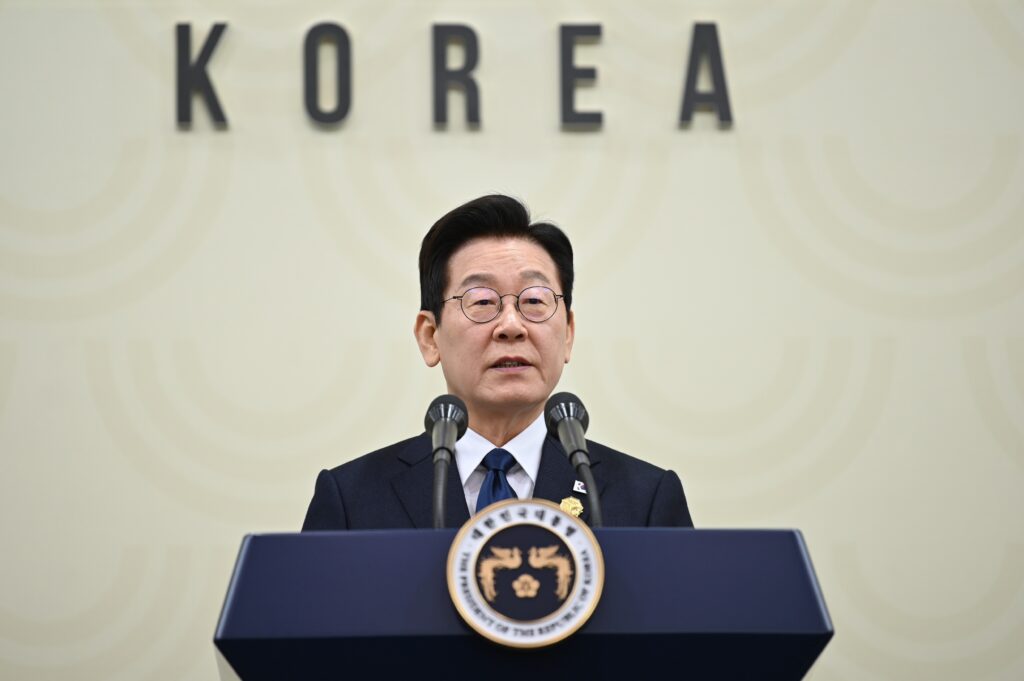Analyses / Asia-Pacific
6 November 2025
APEC Summit: South Korea Enters the League of the “Great Powers”

South Korea hosted the Asia-Pacific Economic Cooperation Forum (APEC) in the city of Gyeongju from 29 October to 1 November 2025. A major diplomatic test for President Lee Jae-myung, who took office in June, the summit and its organisation were marked by significant bilateral meetings with his American and Chinese counterparts, by the encounter between Presidents Donald Trump and Xi Jinping, as well as by the presence of Japan’s new Prime Minister, Sanae Takaichi.
Faced with partners and close neighbours – the United States, China, and Japan – with whom relations remain delicate, South Korea sought to steer the event by balancing global interests and its more national agenda. These ambitions were, however, undermined by the attention drawn to President Trump’s long Asian tour (26–30 October 2025), which took place in parallel. This was Trump’s first trip to the region, including the ASEAN Summit in Malaysia, official visits to Japan and South Korea, and only a minimal participation in the APEC summit, largely overshadowed by his meeting with President Xi Jinping on 30 October, after which Trump returned to Washington. The APEC summit therefore provided President Lee with an opportunity to implement the delicate policy of balance between China and the United States that lies at the heart of Seoul’s foreign policy.
Since the end of the Korean War in 1953, South Korean diplomacy has been characterised by the search for a middle ground between its desire for autonomy and the need to maintain both its security alliance with the United States and good trade relations with China, to ensure its defence and prosperity. Consequently, Seoul’s strategic choices remain constrained by the relative weakness of a country surrounded by powerful neighbours – China, the United States, Japan, and Russia – a situation vividly illustrated by President Lee’s discussions with his American and Chinese counterparts at the APEC summit.
The partial resolution of tariff tensions with the United States
The South Korean side did not escape ongoing tough tariff negotiations with the United States, aimed at reducing American customs duties and easing the uncertainty weighing on Seoul’s economy, which is highly dependent on international trade. It will be recalled that President Lee travelled to Washington in July 2025, where an agreement was announced under which Washington would reduce its tariffs from 25% to 15% in exchange for a $350 billion investment by Seoul in the United States. Yet this announcement was never formalised and led to conflicting statements between the two leaders: Lee Jae-myung claimed that significant points of disagreement remained, while Donald Trump described the deal as nearly finalised.
South Korean car manufacturers – with automobiles being a key export to the United States – are currently subject to 25% tariffs, prompting Lee to seek the conclusion of the agreement. However, he also wished to avoid rushing into a commitment before trying to reduce the scale of the expected investment. At first glance, it seems that the US–South Korea discussions took place in a less favourable atmosphere than those between President Trump and the Japanese Prime Minister. Major Japanese corporations are expected to invest in 21 large-scale joint projects with the United States in sectors such as nuclear energy, logistics, artificial intelligence, and critical minerals, as part of a $550 billion bilateral trade agreement.
However, the authorisation granted by Donald Trump to South Korea to build nuclear-powered submarines – announced after the close of APEC – suggests that negotiations were conducted more on the strategic than on the commercial front.
The North Korean issue also surfaced briefly during Trump’s short stay in Seoul. He repeatedly expressed his desire to re-engage with Kim Jong-un. Yet the geopolitical environment on the Korean Peninsula is vastly different from that of Trump’s first term, when he met the North Korean leader twice. Since then, North Korea has significantly strengthened its ties with China and Russia and, as such, has little incentive to engage with the United States. Trump’s overtures are therefore unlikely to resonate in Pyongyang in the short or medium term. While progress had seemed possible in 2018 and 2019, Kim Jong-un – who had hoped for a partial lifting of US sanctions – was disappointed by his early encounters with Trump and now believes he cannot trust the United States.
Reviving relations with China
President Lee’s meeting with his Chinese counterpart was also significant, marking Xi Jinping’s first visit to South Korea since 2014. The two neighbours maintain strong trade relations, but their political ties have been strained by the growing strategic rivalry between China and the United States. Recalling the historical and cultural bonds between the two countries, Xi Jinping described them as “partners who cannot be separated”, though in reality Seoul finds itself caught between two fires in the trade and technology war between the superpowers.
China recently imposed sanctions on five American subsidiaries of the South Korean shipbuilder Hanwha Ocean, accusing them of aiding the United States. Moreover, many actors in South Korea’s key industries – semiconductors, electronics, and steel – are increasingly concerned about the advances of their Chinese competitors.
Economic hardship among the South Korean population, particularly the youth, has fuelled anti-Chinese sentiment under the influence of populist and conspiracy-driven movements reminiscent of MAGA. Polls show a deterioration of public opinion towards China, while local media report violent protests targeting neighbourhoods with large Chinese populations. The recent introduction of a visa exemption for Chinese tourists – aimed at stimulating the economy, as Japan has done – has intensified the backlash, particularly amid hostility towards Chinese real estate investments.
In this context, President Lee’s goal of easing trade relations with Washington while avoiding alienation from Beijing was only partially achieved. In practice, both Seoul and Beijing seemed more focused on their respective, and more pressing, discussions with the United States.
Ongoing rapprochement between South Korea and Japan
A positive development, however, has been the continued improvement in relations between South Korea and Japan, largely facilitated during Joe Biden’s presidency. Japan’s new Prime Minister, Sanae Takaichi, clearly sought to capitalise on this positive momentum in her discussions with Lee Jae-myung. Their meeting was part of Tokyo’s broader efforts to counter a more assertive China by strengthening partnerships with like-minded Indo-Pacific nations.
Despite having previously made harsh remarks about Japan, President Lee showed openness to rapprochement, as had already begun under Takaichi’s predecessor, Shigeru Ishiba. For her part, the new Japanese Prime Minister, known for her conservative worldview, has so far been careful to avoid any statements or gestures that might recall the darkest chapters of the two countries’ shared history during Japan’s colonisation of Korea between 1910 and 1945. In her policy speech to the Japanese Parliament on 25 October, she clearly indicated her intention to engage in high-level dialogue with Seoul to strengthen bilateral relations. She also declared her aim to develop minilateral security partnerships centred on South Korea, the Philippines, and Australia.
In the same speech, Sanae Takaichi did not hesitate to describe the military activities of China, North Korea, and Russia as a “serious concern”, prompting a protest from Beijing. While she also called for frank dialogue with Chinese leaders, she once again defied Beijing’s anger by meeting representatives from Taiwan invited to the APEC Summit.
Conclusion
The final communiqué adopted at the end of the APEC Summit failed to conceal the deterioration of international trade rules, now undermined by Donald Trump’s mercantilist policies. Once again caught between the diverging positions of China and the United States, President Lee Jae-myung chose to omit any reference to the World Trade Organization (WTO) in favour of a more pragmatic text addressing the concrete challenges facing major Asian economies – from advances in artificial intelligence (AI) to demographic decline.

